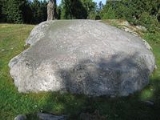
Granby Runestone
Encyclopedia
The Granby Runestone designated as U 337 under the Rundata
catalog, is the longest Viking Age
runic inscription located in Uppland
, Sweden
.
The runic text states that the inscription was carved by the runemaster
Visäte
, who was active in Uppland during the last half of the eleventh century. There are seven other runestones signed by Visäte in Uppland, including U 74 in Husby, U 208 in Råcksta, U 236 in Lindö, U 454 in Kumla, U 669 in Kålsta, U 862 in Säva, and U Fv1946;258
in Fällbro. In the runic text Visäte spelled Guð ("God") using an o-rune instead of a u-rune, an alternative spelling which he also used on U 74 and in spelling the name Guðlaug on U Fv1972;172 in Lilla Vilunda.
The inscription is classified as being carved in runestone style Pr4, which is also known as the Urnes style
. Inscriptions in this runestone style are characterized by slim and stylized animals that are interwoven into tight patterns. The animal heads are typically seen in profile with slender almond-shaped eyes and upwardly curled appendages on the noses and the necks.
Rundata
The Scandinavian Runic-text Data Base is a project involving the creation and maintenance of a database of runic inscriptions. The project's goal is to comprehensively catalog runestones in a machine-readable way for future research...
catalog, is the longest Viking Age
Viking Age
Viking Age is the term for the period in European history, especially Northern European and Scandinavian history, spanning the late 8th to 11th centuries. Scandinavian Vikings explored Europe by its oceans and rivers through trade and warfare. The Vikings also reached Iceland, Greenland,...
runic inscription located in Uppland
Uppland
Uppland is a historical province or landskap on the eastern coast of Sweden, just north of Stockholm, the capital. It borders Södermanland, Västmanland and Gästrikland. It is also bounded by lake Mälaren and the Baltic sea...
, Sweden
Sweden
Sweden , officially the Kingdom of Sweden , is a Nordic country on the Scandinavian Peninsula in Northern Europe. Sweden borders with Norway and Finland and is connected to Denmark by a bridge-tunnel across the Öresund....
.
Description
The Granby Runestone has a runic inscription carved on a boulder consisting of a memorial to a father, a mother and some other people. The father Finnvid's property is mentioned. Some of these family members are mentioned on the inscriptions on other local runestones. Kalfr is mentioned on inscriptions U 338 and U 341, which are located in Söderby, and on U 342, which is also located in Granby, and Ragnfríðr is mentioned on U 338.The runic text states that the inscription was carved by the runemaster
Runemaster
A runemaster or runecarver is a specialist in making runestones.Most early medieval Scandinavians were probably literate in runes, and most people probably carved messages on pieces of bone and wood. However, it was difficult to make runestones, and in order to master it one also needed to be a...
Visäte
Visäte
Visäte was a runemaster who was active during the last half of the eleventh century in southern Uppland, Sweden.-Work:...
, who was active in Uppland during the last half of the eleventh century. There are seven other runestones signed by Visäte in Uppland, including U 74 in Husby, U 208 in Råcksta, U 236 in Lindö, U 454 in Kumla, U 669 in Kålsta, U 862 in Säva, and U Fv1946;258
Uppland Runic Inscription Fv1946;258
This runic inscription, designated as U Fv1946;258 in the Rundata catalog, is on a Viking Age memorial to two fathers that is located in Fällbro, which is about 5 kilometers northwest of Täby, Stockholm County, Sweden, which is in the historic province of Uppland.-Description:This inscription was...
in Fällbro. In the runic text Visäte spelled Guð ("God") using an o-rune instead of a u-rune, an alternative spelling which he also used on U 74 and in spelling the name Guðlaug on U Fv1972;172 in Lilla Vilunda.
The inscription is classified as being carved in runestone style Pr4, which is also known as the Urnes style
Urnes style
The Urnes style was the last phase of Scandinavian animal art during the second half of the 11th century and in the early 12th century. The preceding phases of Scandinavia's Viking Age animal ornamentation are usually categorized as Oseberg style, Borre style, Jelling style, Mammen style and...
. Inscriptions in this runestone style are characterized by slim and stylized animals that are interwoven into tight patterns. The animal heads are typically seen in profile with slender almond-shaped eyes and upwardly curled appendages on the noses and the necks.
Inscription
A transliteration of the runic inscription into roman letters is:- + hemik + uk + sialfi + uk + iohan + þeiR + lata hakua + eftR + faþur sin + finuiþ + uk + uarkas × uk × rahnfriþ + uk moþur sina + uk + at + ikikerþi + uk + at + kalf + uk + kiarþar + u- ...-at + (h)an ati ' ein × alt fyrst × þat × uaru × freantr þeia + koþ : hialbi + ant þaira + uiseti + risti × runa þisa
Other sources
- The article Runristare - Swedish Museum of National AntiquitiesSwedish Museum of National AntiquitiesSwedish Museum of National Antiquities is a museum located in Stockholm, Sweden that covers Swedish cultural history and art from the Stone Age to the 16th century...
.
External links
- Photography of stone and information - Swedish National Heritage Board.
- A page with a drawing at the Stockholm County Museum.

